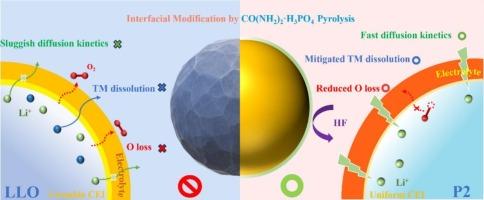Interfacial potential regulation by spinel heterostructure to mitigate oxygen evolution in Lithium-Rich materials
IF 22
1区 材料科学
Q1 MATERIALS SCIENCE, MULTIDISCIPLINARY
引用次数: 0
Abstract
Lithium-rich Layered Oxides (LLO), characterized by their high theoretical capacity, have been identified as a key contender in the realm of lithium-ion batteries. Nevertheless, the structural degradation and voltage decay issues have impeded the commercialization of this material. In this study, a urea phosphate pyrolysis-induced modification combined with multiple synergistic modifications has been introduced for lithium-rich materials, achieving high electrochemical activity retention. During the thermal decomposition of urea phosphate, PO43-, NH3 and CO2 are released, which can induce Li/O vacancies in lithium-rich materials and the transformation of the surface layered structure to spinel structure. Various in-situ tests demonstrate that the electrical conductivity and structural stability of the material have been improved. After 500 cycles at 1C, the capacity retention rate reached 82.9 %, with a voltage attenuation of only 0.91 mV/cycle. Theoretical calculations indicate a diminished overlap between the TM 3d and O 2p orbitals within the heterostructure, as well as an elevated oxygen vacancy formation energy. The inhibition of oxygen evolution from the LLO material by Li4Mn5O12 is elucidated from the perspective of the reverse electric field generated by the potential difference at the interface. This study proposes a rational design strategy that advances the mechanistic understanding of LLO material modification.

尖晶石异质结构对富锂材料界面电位调节的影响
富锂层状氧化物(LLO)具有较高的理论容量,已被确定为锂离子电池领域的关键竞争者。然而,结构退化和电压衰减问题阻碍了这种材料的商业化。在本研究中,引入了一种磷酸脲热解诱导改性与多种协同改性相结合的富锂材料,实现了高电化学活性保持。磷酸尿素在热分解过程中释放PO43-、NH3和CO2,导致富锂材料中出现Li/O空位,表面层状结构向尖晶石结构转变。各种原位试验表明,材料的导电性和结构稳定性得到了改善。在1C下循环500次后,容量保持率达到82.9%,电压衰减仅为0.91 mV/循环。理论计算表明,在异质结构中,tm3d和o2p轨道之间的重叠减少,氧空位形成能升高。从界面电位差产生的反向电场的角度阐明了Li4Mn5O12对LLO材料析氧的抑制作用。本研究提出了一种合理的设计策略,促进了对LLO材料改性机理的理解。
本文章由计算机程序翻译,如有差异,请以英文原文为准。
求助全文
约1分钟内获得全文
求助全文
来源期刊

Materials Today
工程技术-材料科学:综合
CiteScore
36.30
自引率
1.20%
发文量
237
审稿时长
23 days
期刊介绍:
Materials Today is the leading journal in the Materials Today family, focusing on the latest and most impactful work in the materials science community. With a reputation for excellence in news and reviews, the journal has now expanded its coverage to include original research and aims to be at the forefront of the field.
We welcome comprehensive articles, short communications, and review articles from established leaders in the rapidly evolving fields of materials science and related disciplines. We strive to provide authors with rigorous peer review, fast publication, and maximum exposure for their work. While we only accept the most significant manuscripts, our speedy evaluation process ensures that there are no unnecessary publication delays.
 求助内容:
求助内容: 应助结果提醒方式:
应助结果提醒方式:


